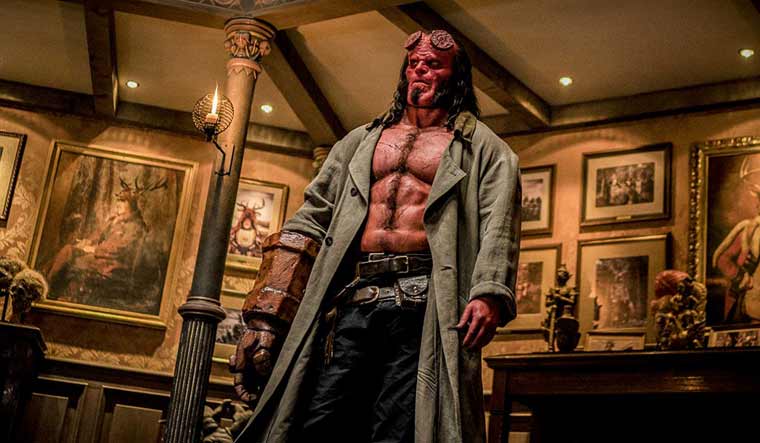As the war of extended superhero universes wages on, fans of such films could be forgiven for thinking that the comic heroes on screen can only be from one of two publishers—DC or Marvel.
But, this weekend, a grizzled contender will appear to challenge DC’s Shazam! at the box office in India. Dark Horse, the publishers behind the source material of films like The Mask (1994), Sin City (2004), 300 (2006) and The Umbrella Academy (2019) will be rebooting a popular franchise in an R-rated avatar— Hellboy.
The film is an R-rated reboot of the comic series by the same name, featuring a demon-human hybrid played by David Harbour who works for the Bureau for Paranormal Research and Defense (BPRD). Hellboy was last seen in film once each in 2004 and 2008, with two well-received adaptations starring Ron Perlman as the iconic red-demon protagonist, and directed by Guillermo del Toro. Hellboy 3, which many fans anticipate dearly, was never made due to funding challenges, creative differences, and Ron Perlman’s growing annoyance at having to put on the heavy makeup.
While the DC and Marvel universes strive towards ever-expanding convergences of its most popular characters, Dark Horse has maintained a uniquely individualistic approach to its several franchises. For one thing, their themes are significantly more “adult” than the usual comic book fare—Sin City is a neo-noir anthology of crime, desire and violence; Hellboy is an action-packed catch-phrase-spewing love letter to Lovecraftian horror; The Umbrella Academy is a bleaker, more goth-pop reflection of the X-men series. In the comic series, No One Left to Fight, the studio tackles the issue of superheroes who have run out of worthy adversaries to fight, with a helpfully descriptive headline: “So you saved the world. Now what?”
The studio’s work has been drawn upon for inspiration and even commissioned for spinoffs for everything from Star Wars to Mass Effect and Stranger Things. Their 1989 comic, Alien Vs Predator, was the inspiration for the massively successful film adaptation in 2004. They also imprint (republish) popular manga from Japan such as Akira, Gantz, Ghost in the Shell and Mob Psycho 100. The manga touch has a heavy influence on the larger studio, which has always sought to blend the styles of Eastern and Western comic worlds. The latest example of this is a manga adaptation of H.P. Lovecraft’s At the Mountains of Madness.
Due to this immense diversity, there is little chance of a Dark Horse Extended Universe of the likes of DC or Marvel. But that does not stop Dark Horse from having a compelling repertoire. Within this repertoire, one series stands out as its must-watch title.
If you had a hard drive filled with films in the mid to late 2000s, you would almost certainly have had Sin City in it. Made by Frank Miller (who also wrote the comic book it was based on), and co-directed by Quentin Tarantino and Robert Rodriguez, it exploded onto the then-stagnant scene of comic-based film adaptations, adding a dose of style, visual flair, and neo-noir cool that was unmatched at the time. Film reviewer Roger Ebert described it as a “comic book brought to life and pumped with steroids”. It ages well to this day.
In an era where comic-based films can feel manufactured, Dark Horse offers a refreshingly different take on things. Part of this can be attributed to the question of artistic ownership. Dark Horse’s biggest brands —Hellboy, Sin City and 300—are all creator-owned. This means that the comic creator maintains a say in how their respective fictional worlds will be built.
In contrast, DC and Marvel are the two biggest examples of publisher-owned franchises, where a big company maintains rights to do whatever they feel like with their purchased source material. Naturally, the interests of corporate shareholders will have significant creative differences with the interests of independent artists.



